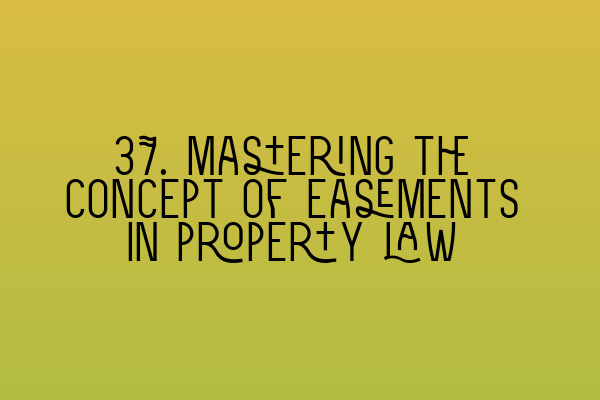Mastering the Concept of Easements in Property Law
When it comes to property law, understanding the concept of easements is crucial. Easements are rights that someone has over another person’s land, allowing them to use or enjoy it in a certain way. These rights can be created by express agreement, implication, or by prescription.
In this article, we will delve into the intricacies of easements, highlighting their importance and how they can impact property transactions. Whether you are a solicitor, law student, or simply interested in property law, this article will provide you with a comprehensive understanding of easements.
What is an Easement?
An easement is a legally recognized right that grants one person (the dominant owner) certain privileges over someone else’s property (the servient owner). These privileges are limited and typically relate to the use and enjoyment of the land.
Easements can vary in nature and scope, but they commonly include rights such as:
1. Right of Way: This allows the dominant owner to pass over the servient owner’s land, often to access their property. A common example is a shared driveway between neighboring properties.
2. Right to Light: This ensures that the dominant owner’s property continues to receive sufficient natural light, preventing the servient owner from obstructing it with new structures or trees.
3. Right to Drain Water: This permits the dominant owner to drain water from their property onto the servient owner’s land, provided it is reasonable and does not cause excessive damage.
4. Right of Support: This guarantees the stability of a building on the dominant owner’s land by prohibiting the servient owner from excavating or constructing anything that could undermine its foundation.
These examples illustrate the diverse nature of easements and how they can impact the use and enjoyment of land.
Creation of Easements
Easements can be created in several ways, each with its own requirements and implications:
1. Express Agreement: An easement can be created through an express agreement between the dominant and servient owners. This usually involves a written document, such as a deed, outlining the terms and conditions of the easement.
2. Implication: Easements can also be implied by law or necessity. For example, if two plots of land were previously under common ownership and one is sold, an easement may be implied to grant the new owner access to the main road.
3. Prescription: Easements can be acquired through long use without interruption or permission. If someone has continuously and openly used another person’s land for a specific purpose, such as a right of way, for a specified period of time (usually 20 years), they may claim an easement by prescription.
Importance of Easements in Property Transactions
Understanding easements is essential when dealing with property transactions. Whether you are buying, selling, or leasing property, it is crucial to identify any existing easements and consider their implications.
For buyers, easements can significantly impact the value and potential use of a property. It is essential to thoroughly investigate the property’s title and ensure that any existing easements are disclosed. Failing to do so may lead to unexpected restrictions on future use or potential legal disputes.
Similarly, sellers should disclose any known easements to potential buyers, ensuring transparency and avoiding potential legal disputes in the future. Professional advice is recommended to ensure all easements are properly documented and disclosed.
For landlords and tenants, easements may affect the rights and responsibilities of each party. It is crucial for both parties to understand existing easements and their impact on the leased property.
Conclusion
Mastering the concept of easements in property law is crucial for anyone involved in property transactions. Whether you are a solicitor, a law student, or someone interested in property law, understanding the intricacies of easements will help you navigate property transactions with confidence.
If you want to further enhance your knowledge in property law or prepare for the SQE (Solicitors Qualifying Examination) exams, check out our related articles and courses:
– SQE 1 Practice Exam Questions
– SQE 1 Practice Mocks FLK1 FLK2
– SQE 2 Preparation Courses
– SQE 1 Preparation Courses
– SRA SQE Exam Dates
These resources will provide you with valuable insights and practice materials to help you excel in your property law studies and professional career. Remember, knowledge is power, and mastering the concept of easements will give you a competitive edge in the field of property law.
